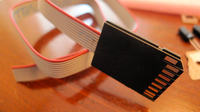wa1kij
Advanced Member level 4
A while back, somebody posted the following question to the UK edition of this forum. He never received a satisfactory answer.
"Has anyone tried to emulate an SD-card, as in, some hardware you plug into an sd-card socket that acts like a physical sd-card, but is backed by some other storage (hard drive, ram, another computer, etc.)?"
Unlike hard drives, overwriting an SD card doesn't completely erase the old data. The only thing that erases the old data is reformatting the card (also unlike a hard drive!) Nevertheless, there are thousands of devices out there that attempt to use SD cards in continuous-overwrite applications.
There are many products on the market that let you substitute an SD card for another form of memory, such as a thumb-drive or a floppy. There is nothing that works the other way around.
"Has anyone tried to emulate an SD-card, as in, some hardware you plug into an sd-card socket that acts like a physical sd-card, but is backed by some other storage (hard drive, ram, another computer, etc.)?"
Unlike hard drives, overwriting an SD card doesn't completely erase the old data. The only thing that erases the old data is reformatting the card (also unlike a hard drive!) Nevertheless, there are thousands of devices out there that attempt to use SD cards in continuous-overwrite applications.
There are many products on the market that let you substitute an SD card for another form of memory, such as a thumb-drive or a floppy. There is nothing that works the other way around.
